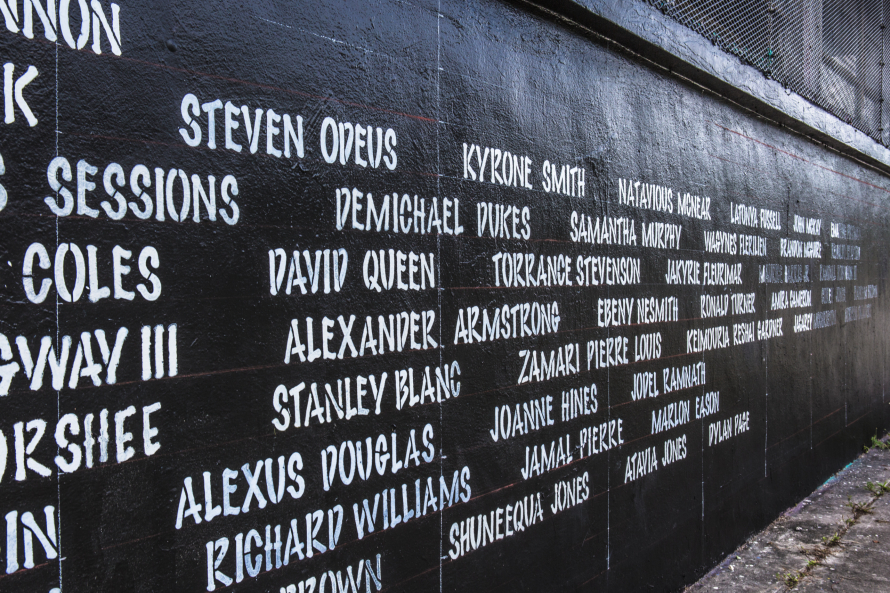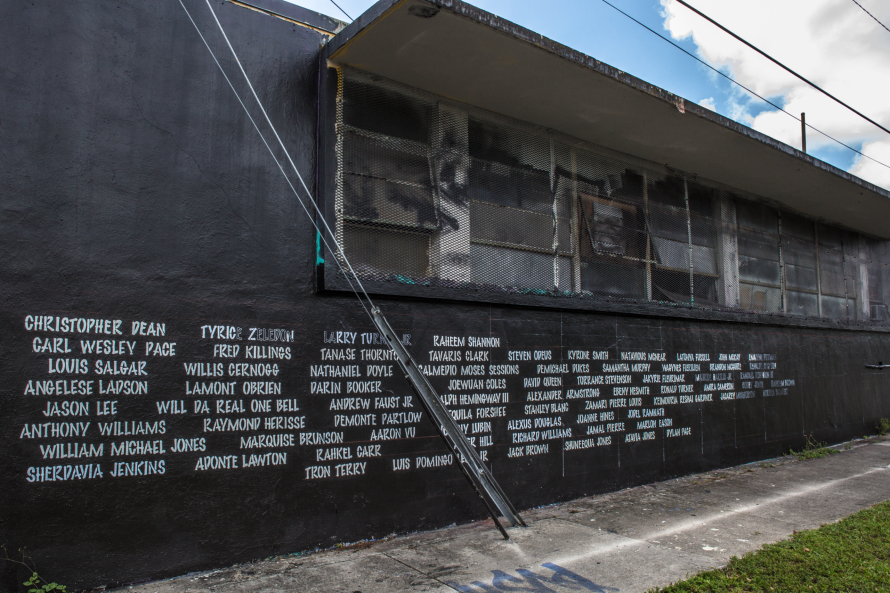
For four-plus years, Miami-based artist Chire Regans has commemorated lives lost to gun violence, telling the stories and carefully rendering portraits of victims. Her largest project, a public memorial titled Say Their Names, spans one city block and is on view at Bakehouse Art Complex. Days before its completion, Oolite Arts awarded Regans its first Social Justice Prize.
Cathy Leff: When did art become your tool of social change?
Chire Regans: I studied medical illustration. On February 27, 2016, six-year-old King Carter of Northwest Miami was killed by a stray bullet. His father posted a live video on Facebook, expressing his pain and loss. It’s uncommon in our culture for a Black man to display emotion publicly. This really struck me. It was all over the media. I thought about my son, then six. I felt helpless, hopeless and questioned, ‘What do I do? What do I do?’ The response came to me, ‘Do what you do best.’ I’m best at drawing and expressing myself visually. I decided to tell this baby’s story. I posted it and similar stories online. It was around the same time Trayvon Martin and Mike Brown were killed. Social media was effective in galvanizing people.
CL: Tell us about your portraits.
CR: My drawings are 9-by-12 inches, on black paper. I mostly use white pencil; sometimes, white charcoal pencil. I initially intended to put the work online. I’ve completed over 200 portraits. I’ve donated some to the families. I do commissioned portraits, but I cannot sell this particular body of work. My subjects always guide my hand. I speak their names aloud and bring them into the work.
CL: Where are you emotionally in the context of recent events?
CR: I go through repeated cycles—anger, rage, helplessness, hopelessness, and focus. The portraits allow me to vent. I can’t allow my emotions to paralyze me. I’m always thinking about what more I can do.

CL: What has been the impact of your work?
CR: It’s on the families. Parents cannot deal with their grief. Seeing their child’s portrait and story allows them to advocate for and speak aloud about their child.
CL: Did you have any direct experience with gun violence?
CR: I lost my closest high school friend, James Reid, III. It had a tremendous impact on me. I’m consoled because he was responsible for so many close friendships I enjoy today. I am not a spectator. I talk about and equally share my loss.
CL: What was the genesis of Say Their Names?
CR: I applied for and received, pre-pandemic, an artist-in-residency fellowship with the Community Justice Project (CJP). I’m housed at Bakehouse Art Complex. Initially, I thought about community activations. COVID-19 changed that. It gave me time to think about how my work could evolve. The memorial just came to me. I wanted to raise awareness of gun violence and bring together CJP’s lawyers, artists and victims of gun violence to understand how to navigate the criminal justice system to become better advocates.
CL: What is different about the mural from other projects?
CR: I am physically creating art in the public realm, simultaneously in dialog with the community, rather than making art for public exhibition and then dialog. The process, scale and duration are distinct. People drive by and return to see progress. Others stop, recognize a name, look for a name or want to offer a name to commemorate. People take photos. They tell me their stories. We share an important moment. I tell them, “This space is for you!”
Life is taken so quickly by gun violence. This project, which has taken months, extends the life of each victim. It acknowledges the importance of labor. Participants think about each person, their life and how they meant something to someone. I’m asked where the victims come from: Ninety percent, South Florida. It’s important for me to honor the lives lost here.

CL: Congratulations on receiving the first Social Justice Prize from Oolite Arts, a $25,000 unrestricted award.
CR: It’s unbelievable! I sometimes feel the need to step back from this work. It’s taken an emotional toll. This prize reminds me I am doing exactly what I am supposed to do.
CL: What’s next?
CL: I’m working on a living memorial of this body of work. I also now want to engage with people who can really change things. I’d like to see a large-scale gun violence memorial in Washington, DC, visualizing the impact of our laws or those we failed to pass and showing losses in real time. Artists always have created memorials. Washington is an important location. Gun violence is a war. We need to confront and memorialize lives lost to this battle.










 in your life?
in your life?

